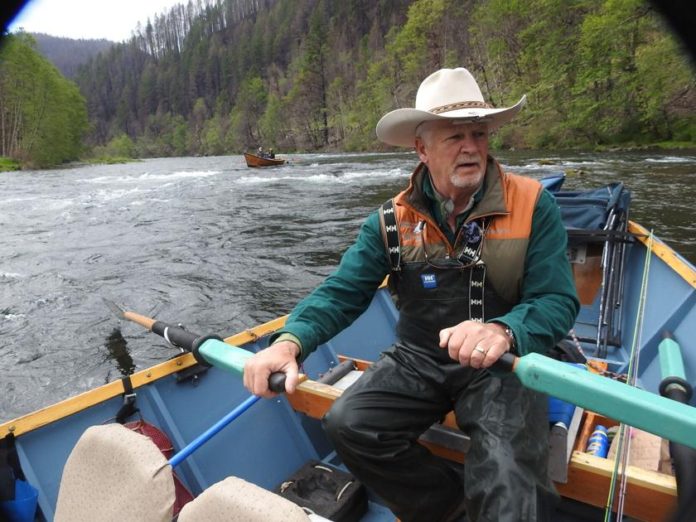We pushed away from the launch at Silver Creek, two McKenzie River wooden driftboats on the river where the driftboat was conceived and crafted. In Ken Helfrich’s boat, I tied on a dry fly while Trevor Barclay wiped rain drops off the lens and Ken lined up for the first rapids. Fifty yards back, on the sticks in his beautiful boat on its refinished maiden voyage, Heath Gunns, with Randy Dersham in the front seat, watched and followed Ken’s line.
Ken tied on a second fly for the leader, tied on a Maxima Chameleon dropper. We would fish McKenzie River-style, which is always different than anywhere else a person fishes.
“Have you heard of the McKenzie River refloat?” Helfrich asked.
He explained: the angler keeps the line high to lift the flies when they began to drag, sometimes skittering the flies upstream like caddis laying eggs. Trout are teased, enticed by a second look, by the action of the flies.
I heard him, understood him, but it was a bit of time before I “refloated” the two-fly cast properly.
It didn’t matter. The trout were not looking up anyway. A low pressure system was blowing through and the temperature had dropped. If fish were bitin’, they were bitin’ each other.
The first part of the float down from Silver Creek to the Leaburg take-out is deceptively calm with easy riffles and a small assortment of sharp boulders to negotiate around. Helfrich pushed through quickly. There was afternoon rain to beat and better water to fish downstream.
On both sides of the river were reminders, fire-blackened trees and small crews salvaging timber. We heard chainsaws and nail guns — a few buildings already being rebuilt.
Late on the night of September 7, 2020, extreme east-west winds blew up a smaller fire that had started a few weeks prior and was burning between McKenzie Bridge and Vida. A month later, the fire had burned 173,000 acres and destroyed over 400 homes and businesses.
Randy Dersham’s property at Nimrod was a total loss — boats, cars, homes, garages and everything inside them.
Helfrich handed me a nymphing rod with an indicator and two beadheads, including a No. 10 Prince Nymph. River left, Helfrich slipped the boat over a shoal and back-ferried in an eddy while I shook out line and made the first cast.
“Shorten up and cast again,” Helfrich whispered. This time the indicator plunged and I set the hook. The fish somersaulted then plunged, fighting along the underwater cliff then streaking out toward the open river. With the long rod and the drag of the line, I was able to turn it and about five minutes later we were able to slide the net under 17 inches of hatchery holdover rainbow trout.
We passed the mouth of Bear Creek and floated Horsetail Rapids. At the tailout of a riffle, we saw a mink pull a trout out of the river. Fierce, it glared our way then dragged its prize up the bank.
Into Marten Rapids Helfrich pointed the boat at a boulder then pulled away, now riding the fence of the eddy, now pulling to slow our momentum, now pushing, now swinging to pull off a rock, catching an eddy again. Wooden boats with flat bottoms and squared-off edges were built to negotiate these rapids and the style of boat came to be known as the McKenzie River drift boat. With subtle moves of his wrists, dipping the oars, pulling back, now powering ahead, Helfrich demonstrated why a wooden driftboat with its superior turning ability is the best choice for a river rock garden.
A salvage logging operation was underway in Ben and Kay Dorris State Park. A helicopter rose above the blackened trees.
Where the river split around a small island Helfrich pointed the squared-off end of the boat into a back channel. Using the nymphing rod, I set the hook into a 16-inch wild McKenzie River redband that took us down through the rapids.
With two great trout and several smaller ones to our credit, I switched to the dry fly rod. We saw yellow mayflies, gray drakes and green caddis. I practiced the McKenzie River refloat and caught half a dozen trout in spite of myself.
Bruised and sullen clouds loomed over Leaburg and we knew the storm was going to hit us. Still we fished.
“Re-cast, closer to the boat,” Helfrich whispered. “Let the flies ride that slick.”
He didn’t have to tell me when to refloat. I lifted the rod, picked up the two-fly cast, dropped it back in. Behind me, Helfrich rolled his left oar one way and the right paddle the other. I felt the boat move, saw the flies pick up again and a trout picked the green caddis dropper off the top of the slick. It was a beautiful thing, oarsman and fly-rodder in perfect sync. And it only took a 9-mile float.
In June sometimes the trout are so competitive, the fish looking up, the trout will clear the water for a fly 6 or 8 inches above the surface. Float and re-float the McKenzie this summer and see it like you have never seen it before.
Gary Lewis is the host of “Frontier Unlimited TV” and author of “Fishing Central Oregon,” “Fishing Mount Hood Country” and other titles. Contact Gary at www.garylewisoutdoors.com
Credit: Source link































